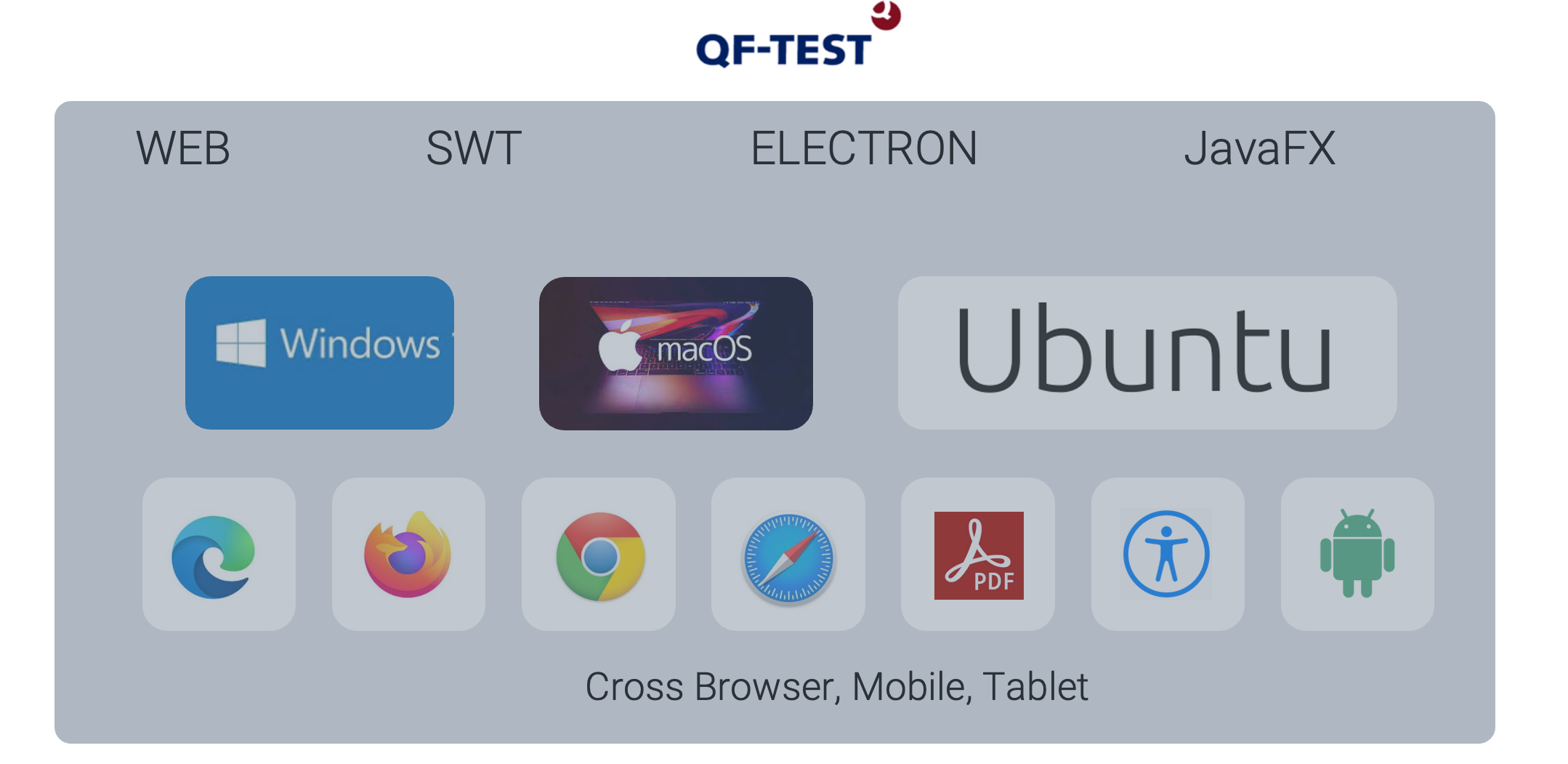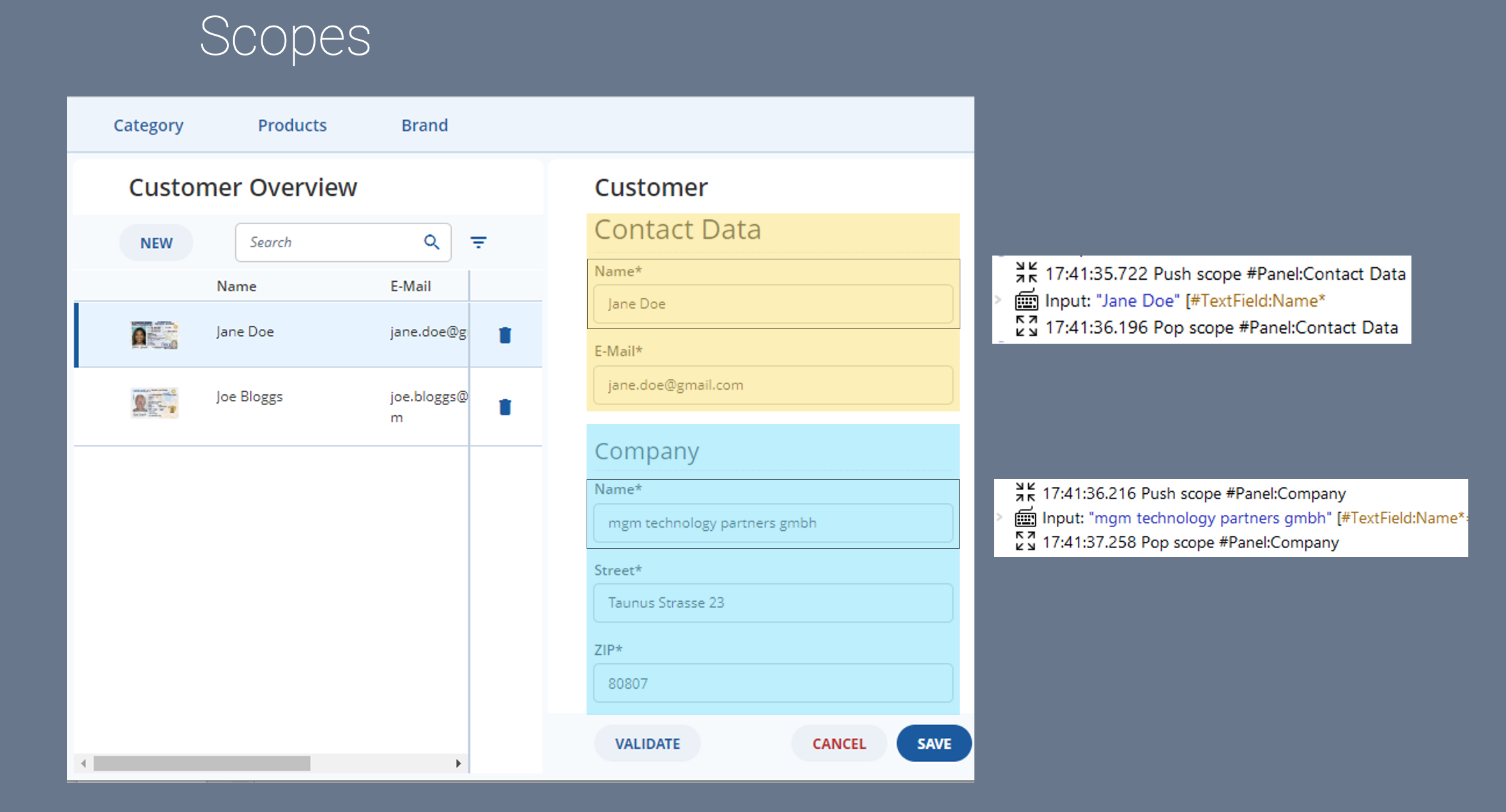mgm had been a customer of Quality First Software (QFS) for over 10 years before the two companies decided to join forces in 2022. Since September 2022, QFS has become a subsidiary of mgm technology partners. Headquartered in Geretsried, Bavaria, the company has achieved impressive and continuous development since its establishment in 2001 with its product, QF-Test. QFS has garnered over 1,500 customers across more than 60 countries, emphasizing quality and customer orientation in its product and support. Despite the rapidly changing world of technology, QF-Test endures. Why is that so?
Concise & to the point
- QF-Test is a comprehensive and in-depth test automation tool for desktop, web, and mobile applications.
- A unique feature of QF-Test is the transformation of the physical user interface into a logical representation, allowing precise component identification through logical screen elements. This results in highly stable displays and significantly reduces maintenance efforts, as modularization is easily achievable.
- In test automation projects at mgm, the effective structuring and modularization of QF-Test are critical success factors.
- The CustomWebResolver plays a crucial role in QF-Test automation for the low-code platform A12 and A12-based web applications. When combined with Scopes and SmartIDs, it enables the implementation of generic software solutions, such as the model-driven test automation tool, mgm A12-ATA.
The long-term maintenance and updating of software applications with constantly changing user interfaces can entail significant effort. Each alteration in the user interface necessitates testing and adjustments, resulting in substantial costs throughout the lifespan of software projects. This is precisely where QFS steps in with the QF-Test tool.
Karlheinz Kellerer, CEO of QFS, explains, “Effective test automation is extensive and has its logic and structure. QF-Test meets the requirements of a broad audience with its user-friendly interface, applicability to various types of applications, support for all relevant web browsers, and seamless integration into different environments. Naturally, our tests require adaptation, but relatively less frequently and, due to the methodologies employed, more straightforward.”
QFS collaborates closely with clients to develop customized solutions for enhancing product and process quality. Gregor Schmid, founder and also CEO of QFS, adds, “Quality always takes precedence for us. The software solutions developed by companies must adhere to the highest standards and deliver flawless performance to their customers. With QF-Test, we have created an application that can adapt to diverse user interfaces independently of industry-specific requirements.”
QF-Test finds extensive application across various industries, including banking, insurance, online portals, ministries, government agencies, and the automotive sector. Furthermore, QF-Test also plays a crucial role in industries where error-free software can literally save lives, such as healthcare, the energy sector, aerospace, and transportation safety.
What is QF-Test?
QF-Test is a tool for comprehensive and in-depth test automation of desktop, web, and mobile applications. It runs on Windows, macOS, and Linux, and also facilitates tests for combined and specialized technologies like Electron and WebSwing. The tool is designed for testers and developers but is also suitable for business analysts and manual testers with no programming knowledge.
QF-Test allows for the automation of individual functions and components within a software application and can also conduct automated testing of complex interconnections and interactions among multiple applications within a system. By automating test cases, particularly regression tests, quality assurance teams can invest their valuable time in a sustainable testing approach. With each automated run of regression tests, manual testing efforts are reduced, ensuring reproducible quality.
“One of the standout features of QF-Test is its ability to transform the physical user interface into a logical one, allowing for precise component recognition through logical screen elements. This results in a highly stable presentation and minimizes maintenance efforts through easily implementable modularization,” explains Gregor Schmid.
The recent “wedding” between QFS and mgm brought great joy, particularly to Lilia Gargouri, the project manager of the mgm Quality Team. She vividly recalls how it all began: “My journey with QFS started on June 27, 2013. As an experienced software developer, I volunteered to revamp the existing QF tests for my project at that time, making them useful in testing phases. That day marked the inception of a success story for me with QF-Test at mgm. It also marked the beginning of an enlightening and fruitful collaboration between the two companies.”
Efficient Structuring and Modularization of QF-Test in mgm Projects with Test Automation
At mgm, QF-Test is employed in projects with test automation in a modular and structured manner. Automation of software testing is an integral part of software development, including quality assurance tests like QF-Tests. Without a structured approach where all elements are systematically organized, there’s a risk of inefficiency and possible failure in test automation. Therefore, an organized and methodical approach is vital in implementing test automation to ensure its purpose is fulfilled and successful.
Each QF-Test case is treated as an independent unit, capable of running independently of other test cases. QF-Test suites are thematically organized and can also be executed individually. The package structure in QF-Test procedure suites mirrors the UI structure of the application. To ease understanding and integration into test automation projects, meaningful names are used for QF-Test procedures and parameters derived from the functionality and headings of the UI. Since test automation is a form of software development, redundant code is avoided. Reusable automated functionalities are centralized in QF-Test procedures and called when necessary in test cases or other procedures.
QF-Test and the A12 Enterprise Low Code Framework The year 2017 marked a crucial turning point for QFS and mgm. Lilia Gargouri recalls: “When using QF-Test for our projects based on the A12 Enterprise Low Code platform, we encountered challenges. The opaque structure of the components necessitated considering alternative approaches to test automation.”

To successfully automate A12, intensive work commenced on the development of a software component known as “CustomWebResolver.” This software component represents the implementation of a QF-Test extension interface and plays a central role in identifying and classifying individual UI elements on the user interface of an A12 web application. “With the help of the resolver, we were able to instruct QF-Test to uniquely classify, recognize, and handle A12 components,” explains the project manager of the mgm Quality Team. The CustomWebResolver is, therefore, highly significant for QF-Test automation in A12 and A12-based web applications.
“The introduction of Scopes and SmartIDs, available since QF-Test Version 6, was, in my opinion, a pivotal leap for QF-Test,” emphasizes Lilia Gargouri.
“By employing this technique in conjunction with the CustomWebResolver, every component on the user interface can be easily and yet precisely identified based on its title, label, or other defined attribute, ensuring stable playback. This technique has enabled us at mgm to implement generic software solutions in test automation, including the model-driven test automation tool, mgm A12-ATA (Automated Test Automation).”
ATA generates the code from the A12 models for QF-Test automation of the A12 forms, including scopes and SmartIDs. Moreover, it features an interpreter with a library that can control all A12 widgets on the user interface using QF-Test. With ATA, automatic filling or testing of A12 forms with minimal QF-Test implementation is feasible. If the A12 models or the user interface change, ATA automatically generates new code for test automation that can be executed directly through QF-Test. This model-driven test automation tool facilitates very early UI test automation.
“We’ve achieved efficiency in our processes by adopting QF-Test on a broad scale. This has been made possible through the development of libraries and other resources, including ATA and the use of the A12 Low-Code platform. Furthermore, we’ve introduced model-driven test automation by implementing a software layer on top of QF-Test. This innovative approach ensures efficiency, whether the user interface undergoes changes or not,” emphasized Lilia Gargouri. “Over a span of 15 years during which the user interface can constantly evolve, we can regenerate the code to identify components at any time and run tests immediately. This guarantees robust and reliable test automation that can adapt to changes in the software environment.”
Collaboration between QFS and mgm
Currently, efforts are underway to integrate QF-Test into the mgm Quality Landscape. This includes providing interfaces between QF-Test and the mgm A12 Test Management Tool (TMT). In the future, TMT is expected to offer a comprehensive overview of test coverage for each project, encompassing both manual and automated tests. Test runs in TMT will also include a selection of both manual and automated tests. Test results will then be centrally collected in TMT. This will help generate more accurate test reports and significantly simplify coordination during the testing phases.
Conclusion
mgm’s experience demonstrates that QF-Test is an extremely versatile product that can be effectively utilized in various contexts. It stands out for its high reliability and provides the necessary interfaces for seamless integration into different environments. This enables stable and sustainable test automation and contributes to avoiding unnecessary costs.











